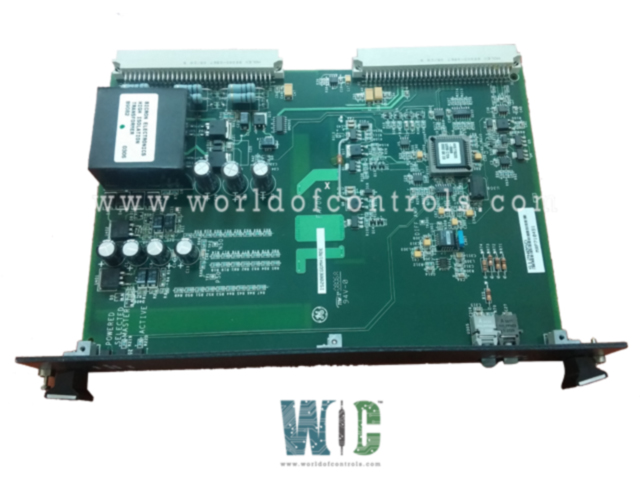SPECIFICATIONS
Part No.: IS200EGDMH1AFF
Manufacturer: General Electric
Country of Manufacture: United States of America (USA)
Operating: 0 to +50°C (32 to +122 °F)
Storage: -40 to +85°C (-40 to +185 °F)
Relative humidity: 5% to 95%, no-condensing
Microprocessor: Intel Pentium M processor 1.6 GHz
Compact Flash Module: 128 MB
L2 cache: 256 KB
Flash-backed SRAM: 8K
Operating System QNX Neutrino
Product Type: Exciter Ground Detector Module
Availability: In Stock
Series: EX2100
Functional Description
IS200EGDMH1AFF is a Exciter Ground Detector Module developed by GE. It is a part of EX2100 control system. The Ground Detection Module is specifically designed to monitor ground leakage resistance in the generator field circuit, ensuring system safety and integrity. This module is characterized by its double slot, double height (6U) form factor, making it suitable for mounting in the Exciter Power Backplane rack (EPBP).
Features
- Functionality: The primary function of the module is to detect field leakage resistance between any point in the generator field circuit and ground. This detection capability extends to both the AC and DC sides of the circuit. By continuously monitoring ground resistance, the module helps prevent potential electrical faults and ensures the reliable operation of the excitation control system.
- System Configuration: In a simplex configuration, a single module is deployed within the system. However, in a redundant setup, three modules are utilized to enhance system reliability. This redundancy ensures that even in the event of a module failure, the system can continue to operate without compromising performance or safety.
- Installation and Mounting: The module's design facilitates easy integration into the Exciter Power Backplane rack (EPBP). Its double slot, double height form factor allows for secure mounting within the rack, ensuring stability and proper functionality. Installation procedures are straightforward, enabling efficient deployment within the excitation control system.
- EGDM Communication: To effectively monitor ground leakage resistance, the EGDM(s) receive voltage signals from the Attenuator Module via a dedicated nine-conductor cable. The module, situated in the High Voltage Module within the Auxiliary Panel, functions as the primary sensor for detecting voltage across the ground sense resistor.
- System Integration and Operation: Once the EXAM module detects voltage variations indicative of ground leakage, it transmits the corresponding signals. These modules then analyze the received signals to assess the ground resistance levels across the generator field circuit. Any deviations from acceptable resistance thresholds trigger appropriate system responses to mitigate potential electrical risks.
- Importance of Proper Placement: The strategic positioning ensures optimal monitoring of ground resistance throughout the generator field circuit. By leveraging the signals relayed from the module, these modules contribute to the early detection and prevention of electrical faults, thereby enhancing system reliability and safety.
Signal Transmission and Configuration Control
- Key information regarding which master (M1 or M2) provides the drive signal to the sense resistor in the Attenuator Module is relayed from the Digital Signal Processor (DSPX) through the EISB in the controller rack to EGDM C. Upon receiving this crucial data via the fiber-optic link, EGDM C takes appropriate action based on the designated master:
- If M2 is the Designated Master: EGDM C powers the relay in the Attenuator Module.
- If M1 is the Designated Master: EGDM C leaves the relay unpowered.
- Additionally, a differential signal is transmitted to both M1 and M2, indicating the selected master. This signal activates the signal generator on the active master and selects the test command source on each module (M1, M2, and C).
Signal Generation and Application
- Following the configuration process, the active master (either M1 or M2) receives an Oscillator Signal via the fiber optic link from the DSPX through the EISB. This signal is converted into a positive or negative 50-volt square wave voltage.
- Subsequently, this voltage is transmitted via cable to the EXAM module and applied to one end of the Sense Resistor, initiating the ground leakage detection process.
Ensuring Redundancy and Reliability
- By implementing a redundant control scheme with three boards, the system ensures continuous monitoring and detection of ground leakage across the generator field circuit. Through meticulous signal transmission and configuration control, the system maximizes redundancy and reliability, minimizing the risk of electrical faults and enhancing operational safety.
The WOC team is always available to help you with your EX2100 requirements. For more information, please contact WOC.
Frequently Asked Questions
What is IS200EGDMH1AFF?
It is a Exciter Ground Detector Module developed by GE under the EX2100 series.
What does the signal conditioner in the EX2100 Excitation Control System do?
The signal conditioner receives an attenuated differential signal from the Sense Resistor in the module.
What is the design of the signal conditioner?
The signal conditioner is designed as a simple unity gain differential amplifier with a high common-mode rejection ratio, followed by an A-to-D converter (Voltage Controlled Oscillator VCO).
How does the signal conditioner transmit signals?
The VCO feeds a fiber optic transmitter, ensuring efficient and reliable signal transmission.
